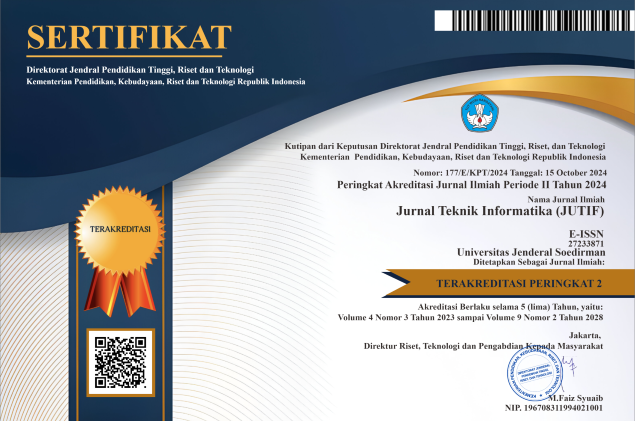DETECTION OF BULLYING CONTENT IN ONLINE NEWS USING A COMBINATION OF RoBERTa-BiLSTM
DOI:
https://doi.org/10.52436/1.jutif.2025.6.1.4140Keywords:
bullying detection, BiLSTM, news classification, online news, RoBERTaAbstract
This research aims to build a bullying-themed online news classification system with a combined approach of RoBERTa embedding and BiLSTM. RoBERTa is used to generate context-rich text representations, while BiLSTM captures temporal relationships between words, thereby improving classification performance. The research dataset consisted of news from reputable portals such as Kompas.com, Detik.com, and iNews.com, labeled according to keywords relevant to the theme of bullying. The results of the experiment showed that the model achieved 95.2% accuracy, 98.2% precision, 93.6% recall, and 95.8% F1-score. Although there are few prediction errors (false positives and false negatives), this model shows excellent performance in detecting and classifying bullying-themed news. The main contribution of this research is the development of a new approach that combines RoBERTa and BiLSTM for the classification of complex bullying-themed news. This approach not only improves the accuracy of classification but can also be implemented in automated systems to detect negative content. Thus, this research has the potential to support the creation of a healthier digital space and encourage more responsible media practices.
Downloads
References
J. Song, K. Kim, Y. Han, and T. M. Song, “Classification of Bullying-Related Web Documents: An Ecological Systems and Machine Learning Approach,” Jan. 29, 2023, Social Science Research Network, Rochester, NY: 4341006. doi: 10.2139/ssrn.4341006.
S. Salawu, Y. He, and J. Lumsden, “Approaches to Automated Detection of Cyberbullying: A Survey,” IEEE Transactions on Affective Computing, vol. 11, no. 1, pp. 3–24, Jan. 2020, doi: 10.1109/TAFFC.2017.2761757.
F. A. Nirmala, M. Jazman, N. E. Rozanda, and F. N. Salisah, “CYBERBULLYING SENTIMENT ANALYSIS OF INSTAGRAM COMMENTS USING NAÏVE BAYES CLASSIFIER AND K-NEAREST NEIGHBOR ALGORITHM METHODS,” Jurnal Teknik Informatika (Jutif), vol. 5, no. 5, Art. no. 5, May 2024, doi: 10.52436/1.jutif.2024.5.5.1997.
B. I. Kusuma and A. Nugroho, “CYBERBULLYING DETECTION ON TWITTER USES THE SUPPORT VECTOR MACHINE METHOD,” Jurnal Teknik Informatika (Jutif), vol. 5, no. 1, Art. no. 1, Jan. 2024, doi: 10.52436/1.jutif.2024.5.1.809.
M. F. Hibatulloh, D. N. Suci, A. G. Puspita, and I. F. Rohmah, “A Critical Discourse Analysis on Antara English News Reports About Bullying in Education Institutions in Indonesia,” 1, vol. 5, no. 3, Art. no. 3, Oct. 2023, Accessed: Nov. 07, 2024. [Online]. Available: http://elitejournal.org/index.php/ELITE/article/view/198
A. D. Gower, T. Vaillancourt, H. Brittain, K. Pletta, and M. A. Moreno, “185. Understanding News Media Coverage On Bullying And Cyberbullying,” Journal of Adolescent Health, vol. 64, no. 2, p. S94, Feb. 2019, doi: 10.1016/j.jadohealth.2018.10.201.
L. B. Angizeh and M. R. Keyvanpour, “Detecting Fake News using Advanced Language Models: BERT and RoBERTa,” in 2024 10th International Conference on Web Research (ICWR), Apr. 2024, pp. 46–52. doi: 10.1109/ICWR61162.2024.10533352.
Y. Sagama and A. Alamsyah, “Multi-Label Classification of Indonesian Online Toxicity using BERT and RoBERTa,” in 2023 IEEE International Conference on Industry 4.0, Artificial Intelligence, and Communications Technology (IAICT), Jul. 2023, pp. 143–149. doi: 10.1109/IAICT59002.2023.10205892.
M. Fakhry and A. F. Brery, “A Comparison Study on Training Optimization Algorithms in the biLSTM Neural Network for Classification of PCG Signals,” in 2022 2nd International Conference on Innovative Research in Applied Science, Engineering and Technology (IRASET), Mar. 2022, pp. 1–6. doi: 10.1109/IRASET52964.2022.9738309.
M. M. Rahman, A. I. Shiplu, Y. Watanobe, and M. A. Alam, “RoBERTa-BiLSTM: A Context-Aware Hybrid Model for Sentiment Analysis,” Jun. 01, 2024, arXiv: arXiv:2406.00367. doi: 10.48550/arXiv.2406.00367.
R. Mohawesh, H. B. Salameh, Y. Jararweh, M. Alkhalaileh, and S. Maqsood, “Fake review detection using transformer-based enhanced LSTM and RoBERTa,” International Journal of Cognitive Computing in Engineering, vol. 5, pp. 250–258, Jan. 2024, doi: 10.1016/j.ijcce.2024.06.001.
Q. Pu and F. Li, “RoBERTa-BiLSTM: A Chinese Stance Detection Model,” in 2024 5th International Seminar on Artificial Intelligence, Networking and Information Technology (AINIT), Mar. 2024, pp. 2199–2203. doi: 10.1109/AINIT61980.2024.10581713.
S. Zhang et al., “Multi-Modal Emotion Recognition Based on Wavelet Transform and BERT-RoBERTa: An Innovative Approach Combining Enhanced BiLSTM and Focus Loss Function,” Electronics, vol. 13, no. 16, Art. no. 16, Jan. 2024, doi: 10.3390/electronics13163262.
A. Bhamre, “Detection of Cyberbullying using BiLSTM,” IJRASET, vol. 12, no. 4, pp. 5161–5163, Apr. 2024, doi: 10.22214/ijraset.2024.60420.
L. B. Angizeh and M. R. Keyvanpour, “Detecting Fake News using Advanced Language Models: BERT and RoBERTa,” in 2024 10th International Conference on Web Research (ICWR), Apr. 2024, pp. 46–52. doi: 10.1109/ICWR61162.2024.10533352.
H. Xu, X. Guo, and J. Zhao, “RoBERTa-wwm-CBA: A Mental Disease Identification Model Based on RoBERTa-wwm and Hybrid Neural Networks,” in Neural Computing for Advanced Applications, Singapore: Springer Nature, 2025, pp. 246–258. doi: 10.1007/978-981-97-7001-4_18.
T. Fu, A. Abbasi, D. Zeng, and H. Chen, “Sentimental spidering: leveraging opinion information in focused crawlers,” ACM Trans Inf Syst (TOIS), vol. 30, 2012, doi: 10.1145/2382438.2382443.
Y. Fauziah, B. Yuwono, and A. S. Aribowo, “Lexicon Based Sentiment Analysis in Indonesia Languages : A Systematic Literature Review,” RSF Conference Series: Engineering and Technology, vol. 1, no. 1, Art. no. 1, 2021, doi: 10.31098/cset.v1i1.397.
F. T. Saputra, S. H. Wijaya, Y. Nurhadryani, and Defina, “Lexicon Addition Effect on Lexicon-Based of Indonesian Sentiment Analysis on Twitter,” in 2020 International Conference on Informatics, Multimedia, Cyber and Information System (ICIMCIS), Nov. 2020, pp. 136–141. doi: 10.1109/ICIMCIS51567.2020.9354269.
M. M. Rahman, A. I. Shiplu, Y. Watanobe, and M. A. Alam, “RoBERTa-BiLSTM: A Context-Aware Hybrid Model for Sentiment Analysis,” Jun. 01, 2024, arXiv: arXiv:2406.00367. Accessed: Nov. 20, 2024. [Online]. Available: http://arxiv.org/abs/2406.00367
Y. Liu et al., “RoBERTa: A Robustly Optimized BERT Pretraining Approach,” Jul. 26, 2019, arXiv: arXiv:1907.11692. doi: 10.48550/arXiv.1907.11692.
N. A. P. Masaling and D. Suhartono, “Utilizing RoBERTa and XLM-RoBERTa pre-trained model for structured sentiment analysis,” International Journal of Informatics and Communication Technology (IJ-ICT), vol. 13, no. 3, Art. no. 3, Dec. 2024, doi: 10.11591/ijict.v13i3.pp410-421.
S. Akpatsa et al., “Online News Sentiment Classification Using DistilBERT,” JQC, vol. 4, no. 1, pp. 1–11, 2022, doi: 10.32604/jqc.2022.026658.
A. S. Rahayu, A. Fauzi, and R. Rahmat, “Komparasi Algoritma Naïve Bayes Dan Support Vector Machine (Svm) Pada Analisis Sentimen Spotify,” Jurnal Sistem Komputer Dan Informatika (Json), vol. 4, no. 2, p. 349, 2022, doi: 10.30865/Json.V4i2.5398.
R. Azhar and M. F. Wijayanto, “Analisis Sentimen di Twitter: Mengungkap Persepsi dan Emosi Publik Seputar Konflik Palestina-Israel,” Seminar Nasional Teknologi & Sains, vol. 3, no. 1, Art. no. 1, Jan. 2024, doi: 10.29407/stains.v3i1.4132.
S. Mujilahwati, M. Sholihin, R. Wardhani, and M. R. Zamroni, “Python Based Machine Learning Text Classification,” J. Phys.: Conf. Ser., vol. 2394, no. 1, p. 012015, Dec. 2022, doi: 10.1088/1742-6596/2394/1/012015.
D. F. Sebastian, H. Sulistiani, and A. R. Isnain, “SENTIMENT ANALYSIS OF PUBLIC OPINION ON THE RIGHT OF INQUIRY IN INDONESIA IN 2024 USING THE SUPPORT VECTOR MACHINE (SVM) METHOD,” Jurnal Teknik Informatika (Jutif), vol. 5, no. 4, Art. no. 4, Jul. 2024, doi: 10.52436/1.jutif.2024.5.4.1968.
E. Sari, L. Afuan, I. Permadi, E. Maryanto, and S. P. Rahayu, “CORRELATION ANALYSIS OF SENTIMENT OF 2024 ELECTION RESULTS AND STOCK MOVEMENTS OF POLITICAL ACTORS IN INDONESIA,” Jurnal Teknik Informatika (Jutif), vol. 5, no. 4, Art. no. 4, Aug. 2024, doi: 10.52436/1.jutif.2024.5.4.2701.
M. Anjani and H. N. Irmanda, “COMPARISON PERFORMANCE OF WORD2VEC, GLOVE, FASTTEXT USING SUPPORT VECTOR MACHINE METHOD FOR SENTIMENT ANALYSIS,” Jurnal Teknik Informatika (Jutif), vol. 5, no. 3, Art. no. 3, May 2024, doi: 10.52436/1.jutif.2024.5.3.1366.


























